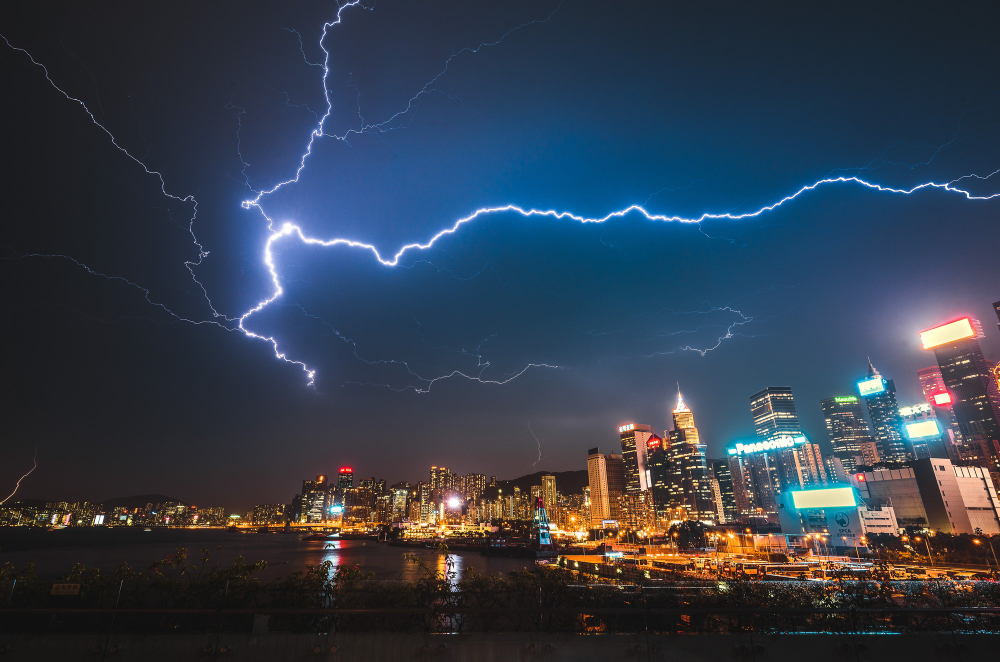Table of Contents
Lightning is one of nature’s most powerful and awe-inspiring forces. With every strike, millions of volts of electricity are released in a split second. The sheer energy of a lightning bolt has fascinated scientists and the general public alike, sparking the question: can we capture lightning and use its energy in the electrical grid? In this article, we will explore the scientific possibilities, the myths surrounding the idea, and the challenges that make this endeavor far more complex than it seems.
The Potential Power of a Lightning Bolt
A single lightning strike can carry about 1 billion joules of energy, which seems like an immense amount. For comparison, that’s enough to power a 100-watt lightbulb for about 116 days. Theoretically, it could power a small town for a brief moment. This high-voltage energy is why the idea of capturing lightning is so enticing. If humanity could harness the energy of every storm, it might contribute significantly to the world’s power needs. However, capturing and storing this energy comes with immense scientific and engineering challenges.
Myth: Lightning Can Be Easily Captured and Stored
One of the most persistent myths is that we could easily “trap” lightning with large metal towers or other types of equipment, and then store it for later use in the grid. While this idea seems logical, the practical issues arise due to the nature of lightning itself.
Lightning is unpredictable, both in terms of when and where it strikes. Even if a system could be designed to capture a bolt of lightning, the next challenge lies in controlling the sudden, massive burst of energy. Lightning delivers its energy almost instantaneously, in less than a second, which makes it difficult to capture efficiently and prevent wastage.
Fact: Capturing Lightning Requires Unprecedented Technology
In theory, a lightning bolt could be captured using a tall metal structure—like a lightning rod—but that’s where the simplicity ends. The challenge is not just capturing the energy, but safely converting and storing it. Current energy storage technologies, such as batteries and capacitors, are not designed to handle the immediate and explosive release of energy that lightning brings.
- Conversion: The energy in a lightning strike is high-voltage, but to store and distribute it efficiently, it would need to be converted to a lower, manageable voltage for conventional storage systems. The technology required to safely convert lightning energy would need to handle extreme surges, which poses a significant engineering challenge.
- Storage: Even if lightning energy could be captured, existing energy storage systems such as lithium-ion batteries or even supercapacitors do not have the capacity to absorb and hold such an intense charge in the short time it is delivered. Specialized capacitors designed to handle such enormous and rapid energy inputs are under development, but they are not yet capable of storing enough energy for practical long-term use.
Scientific Studies on Lightning Capture
There have been various scientific attempts and ideas on how to capture lightning energy, but none have proven feasible for large-scale use.
- Artificial Lightning Triggers: Some scientists have experimented with using rockets to trigger lightning strikes in controlled environments. By shooting a rocket with a trailing conductive wire into storm clouds, they can create a controlled lightning strike. While these experiments have helped scientists better understand the mechanics of lightning, the process is far too expensive and dangerous to implement on a commercial scale.
- Capacitive Storage Research: Some research is exploring the use of massive capacitors that could potentially store the energy of a lightning strike. However, current capacitors are not efficient enough to hold the energy for extended periods, and the amount of energy lost during the rapid charge process makes them impractical for capturing lightning.
- Superconductors: Another field of research involves superconductors, which can theoretically store large amounts of energy without resistance. If scientists could develop superconductors that work at higher temperatures, they might offer a way to capture and store the energy from a lightning strike. However, this technology is still far from practical application.
A More Realistic Approach: Energy Harvesting from Thunderstorms
While capturing individual lightning bolts is still far from feasible, some scientists suggest that instead of focusing on the strike itself, we should look at the overall energy potential of thunderstorms. Storms create powerful electromagnetic fields and a significant amount of wind and rain, which could be used to generate energy indirectly.
- Wind and Hydropower: The intense winds and rainfall associated with thunderstorms could be harnessed through advanced wind turbines and hydroelectric systems. These methods would allow us to capture some of the energy created by storms without the difficulties of trying to control the lightning itself.
- Electromagnetic Energy Harvesting: Thunderstorms also produce electromagnetic waves that could theoretically be captured and converted into usable electricity. While the energy yield from this approach would be much lower than a direct lightning strike, it could still provide an additional renewable energy source.
Personal Conclusions: Is Capturing Lightning Worth the Pursuit?
Based on the current scientific understanding, capturing and storing lightning for use in the electrical grid is not feasible with today’s technology. The immense challenges of storage, conversion, and unpredictability make this idea more of a scientific curiosity than a practical solution for the energy needs of the future. However, continued research into extreme energy storage solutions, such as superconductors and advanced capacitors, may one day change that reality.
In the meantime, focusing on alternative ways to harvest energy from storms, such as wind and hydro systems, or even developing technologies to capture electromagnetic waves from storm activity, seems like a more attainable goal. Lightning may not be a usable energy source in the near future, but storms themselves offer a variety of potential renewable resources that we are only beginning to tap into.
Lightning as an Alternative Source of Endless Free Energy: Myth or Reality?
Using lightning as a potential energy source has long captivated scientists and engineers alike. Each lightning strike releases a colossal amount of energy, making it seem like an ideal candidate for use in the electrical grid. However, to understand the feasibility and practicality of this idea, let’s examine real figures, existing developments, and assess the economic viability of constructing such a facility.
The Power of Lightning: How Much Energy Can Be Harvested?
A single lightning strike can carry about 1 to 10 billion joules of energy. For comparison, this equates to approximately 280 kilowatt-hours (kWh) of energy, which is enough to power an average household for about 9 to 10 days. However, it is important to remember that this energy is released in a split second, making it challenging to capture and use efficiently.
Specific Figures:
- Average lightning strike: 1 billion joules = 280 kWh.
- Lightning with maximum power: up to 10 billion joules = 2800 kWh (enough to power a small business for one day).
Existing Developments: How Are They Trying to “Catch” Lightning?
Currently, there have been several attempts and conceptual ideas for capturing lightning, but none have proven commercially successful. Let’s examine some of the most notable projects:
- Rocket-Based Lightning Triggering (TRP)
- In the 1990s, several experiments in the U.S. involved using rockets to provoke lightning strikes, directing them to specially installed lightning rods. Researchers aimed to direct lightning into containers that could store energy. However, these studies revealed that the equipment was unable to effectively retain and process the massive, fleeting energy bursts from lightning.
- The cost of such experiments ran into millions of dollars per launch, but no real energy benefits were gained.
- Lightning Rods and Storage Devices (Computational Model)
- According to a model developed by Japanese scientists in 2010, a single lightning rod could capture up to 10 lightning strikes in a year. The power of one lightning strike is about 280 kWh, totaling approximately 2800 kWh per year. This is a small amount of energy, especially considering the high costs associated with creating the infrastructure and equipment needed for energy storage and conversion.
- The cost of equipment installation for capturing lightning is estimated in the millions of dollars, making the project economically unfeasible with current technology.
Economic Assessment: How Much Does It Cost to Build a Lightning Capture Station?
Let’s break down the costs of establishing a station to capture lightning and evaluate its feasibility:
- Cost of Installing Lightning Rods and Storage Devices
- For effective lightning capture, high lightning rods and energy storage units are required. Constructing a lightning rod tower 200-300 meters high could cost anywhere from $500,000 to $2 million, depending on the region and conditions.
- The energy conversion systems required to transform lightning energy into grid-compatible electricity may also cost an additional $1-2 million per installation.
- The total estimated cost of a facility capable of capturing up to 100 lightning strikes per year is approximately $10-20 million.
- Return on Investment
- If each lightning strike yields about 280 kWh and the installation captures around 100 strikes per year, this would result in a total of 28,000 kWh per year.
- At an average cost of $0.10 per kWh, the annual revenue from such a station would be only $2,800.
- Given the investment of millions of dollars, a lightning capture station would not break even even after 1,000 years at current technology and energy prices.
Alternative Options: How to Utilize Lightning Energy?
Based on the analysis above, capturing lightning as a source of endless free energy does not currently seem practical. However, there are some proposals for how to use related phenomena to extract energy.
- Harnessing Wind and Water Energy Generated by Storms
- Storms produce strong winds and heavy rainfall, which can be harnessed through advanced wind turbines and hydroelectric systems. These solutions have already proven effective and are reliable ways to generate energy.
- Electromagnetic Wave Harvesting
- Thunderstorms generate powerful electromagnetic waves that could theoretically be captured and converted into usable electricity. While this approach yields significantly less energy than direct lightning capture, it could still provide an additional renewable energy source.
Conclusion: Is Catching Lightning Worth the Pursuit?
Currently, the idea of using lightning as an energy source is more associated with myths and hypotheses than with real technical solutions. The technologies required to effectively capture, store, and convert lightning energy either do not exist or are too expensive for practical application. Even considering the power of each lightning strike, the high cost of capturing it and the challenges of storage make this approach unviable.
The main takeaway: lightning cannot become an endless free energy source with current technological capabilities. Alternative methods for harnessing storm energy, such as wind and hydroelectric systems, remain more practical and economically viable.

The Final Word
The idea of capturing lightning remains in the realm of both myth and possibility. While it is not impossible to imagine that future technologies could allow us to harness this powerful force of nature, the current limitations make it an unlikely candidate for large-scale energy production. As we continue to innovate in the fields of energy storage and conversion, the dream of storing a lightning strike may one day come true—but until then, nature’s most spectacular electrical phenomenon remains untamed.



